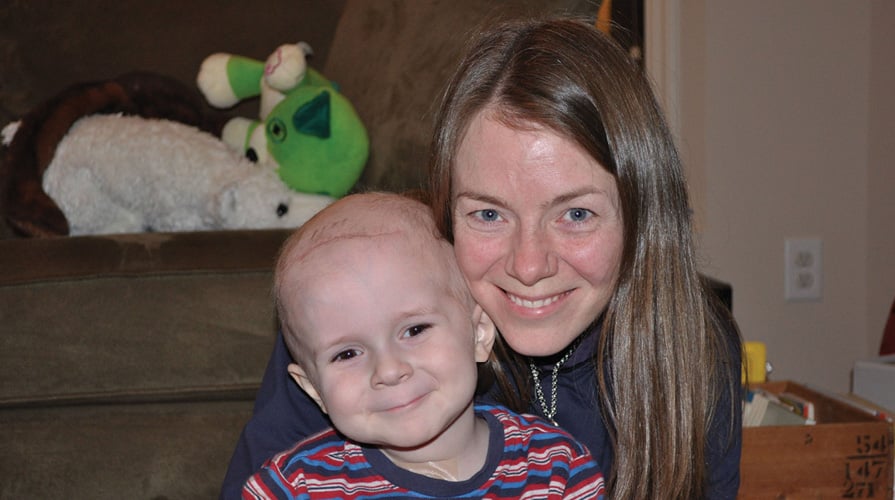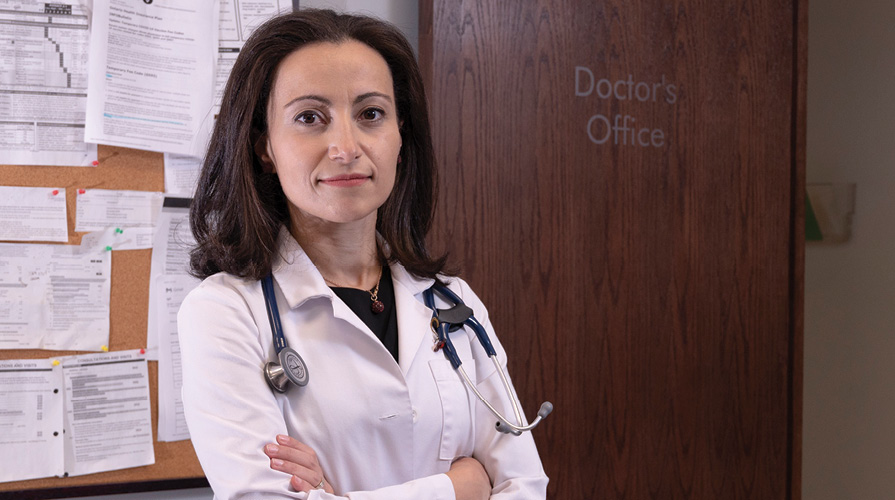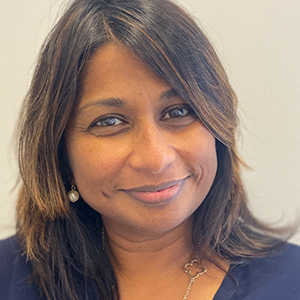This article originally appeared in the Spring 2022 issue of the Ontario Medical Review magazine.
Parents, physicians bear the burden of keeping track of long medical histories
Antonia Palmer has told the story of her son’s medical journey hundreds of times to doctors and other health-care professionals over the years. And each time she does, it brings back the trauma they experienced, and even feelings of blame and guilt.
The story the Mississauga, Ont., mother tells is a tough one. How Nate was diagnosed at two years old with Stage 4, high-risk neuroblastoma, a rare, difficult-to-treat cancer. How he underwent intensive chemotherapy, surgery to remove a kidney, a stem cell transplant, radiation and then immunotherapy, with intense pain as a side effect. How he had a rare relapse in the brain, which required emergency surgery to remove the tumour, cranial spinal radiation, more high-dose chemotherapy, then three years of experimental treatment at Memorial Sloan Kettering in New York City. How he was cancer-free for seven years, before being diagnosed with secondary thyroid cancer last summer.
“When you have a child with a complex medical condition, your child is going to be cared for by multiple specialists in multiple areas, and possibly at different hospitals,” said Palmer during an afternoon Zoom interview.
This season’s OMD Educates webinar series features an array of diverse topics such as coding, privacy and security, quality improvement, eForms, secure messaging, and more.
“When you’re taking your child to all these appointments, and potentially seeing a new doctor each time you go ... you have to retell your child’s story each time.” —Antonia Palmer
“When you’re taking your child to all these appointments, and potentially seeing a new doctor each time you go, depending on how that clinic is structured, or seeing a fellow or someone who is new to the medical field, you have to retell your child’s story each time,” she said.
In Nate’s case, the now-14-year-old is followed by a huge team of specialists — in nephrology, endocrinology, audiology, neurology, respirology, his family doctor and more. If those physicians, and other health-care professionals involved in Nate’s care, had access to a system allowing them to share information about his medical background, “that would have the potential to reduce some of the trauma parents experience, and that would be a really important thing for parents and caregivers,” his mother said.
Palmer’s frustration in dealing with gaps in the medical system echoes concerns raised by Ontario physicians last year when the Ontario Medical Association undertook the largest consultation in its 140-year history.
More than 1,600 doctors shared their views on challenges in the health-care system over an eight-month period, joining 110 health-care stakeholders and close to 8,000 members of the public who outlined their priorities in an online survey. The consultation resulted in the ambitious action plan Prescription for Ontario: Doctors’ 5-Point Plan for Better Health Care.
 Among the plan’s recommendations is to “give every patient a team of health-care providers and link them digitally.” A provincewide digital network that links doctors’ electronic medical records systems, hospital information systems, laboratory and pharmacist systems would result in patients receiving the care they need faster, with fewer errors, because all their health-care providers would be sharing information more quickly and efficiently.
Among the plan’s recommendations is to “give every patient a team of health-care providers and link them digitally.” A provincewide digital network that links doctors’ electronic medical records systems, hospital information systems, laboratory and pharmacist systems would result in patients receiving the care they need faster, with fewer errors, because all their health-care providers would be sharing information more quickly and efficiently.
While some other Canadian provinces have varying levels of digital networks linking some of the major players in the health-care field — doctors’ offices, labs, X-ray, ultrasound and other imaging departments, pharmacies and hospitals — Ontario, as a whole, isn’t there yet. In the OMA 2021 survey, 88 per cent of physicians said they must still use fax technology to share patient information with other physicians, pharmacists and health-care providers.
Of those, 30 per cent said they would save one to five hours a week if they could communicate through linked health record systems. Twenty-two per cent of respondents estimated they would save more than 10 hours a week.
Linking existing digital health records systems would free up administrative time better spent on direct patient care. The OMA action plan estimates that if each of Ontario’s physicians could save one hour a day and see two additional patients, one million more patients could receive care each month.
That could be a game-changer in a province where, even before the COVID-19 pandemic, there were lengthy wait times to see specialists and access treatment and surgeries, and where one million Ontarians can’t find a family doctor. Achieving more time for direct patient care would also be a first step in dealing with the backlog of more than 21 million health-care services that have been delayed due to the pandemic.
Photo: Over the course of her son’s medical journey, Antonia Palmer has had to retell and relive the traumatic experience of sharing her son’s medical history hundreds of times as they met with new specialists both here in Canada and abroad.
Dr. Mariam Hanna, a pediatric allergy, asthma and immunology specialist in Burlington, Ont., is growing impatient with the lack of digital connectiveness in Ontario’s overall health-care system. She spends about 25 per cent of her time getting medical histories from patients — a process that would be more accurate and faster if she had access to patients’ digital records from other doctors, laboratories, pharmacists and other health-care providers.
Dr. Hanna is particularly frustrated because she did her medical training and residency at the University of Alberta in Edmonton, and she experienced the benefits of Alberta’s Netcare system. It gives approved health professionals access to a patient’s laboratory test results, hospital visits, diagnostic imaging, medications, immunizations and other information.
“Coming here as a trainee, I was shocked that Ontario didn’t have this,” said Dr. Hanna, who came to McMaster University for her allergy fellowship, then set up practice six years ago. “It felt like the Stone Ages in Ontario.”
In a typical patient visit at her office, she would likely have a fax from the family doctor with some consult notes and patient history — a fax that could be one page long or 30 pages. As a result, she usually has to rely on a lengthy conversation with the parent or guardian who accompanies her young patients to answer questions about the child’s medical history — doctors they have seen, laboratory tests or X-rays or other procedures they have undergone and when, medications they have tried, other health-related occurrences in the past. “We’re relying almost 100 per cent on patient recall.”
“I think people are honestly going to be shocked at how far behind we are in health technology and utilization. It’s a priority in my book.” —Dr. Mariam Hanna
This is where errors or duplications in procedures and tests can occur, and it takes a lot of time and effort to ensure that doesn’t happen. After the patient has left the office — often with no definitive answers — Dr. Hanna or her staff have to spend valuable time tracking down previous lab results or X-rays or specialist visits or medication history.
“By the end of that 30-minute visit, that patient’s chart isn’t done. There’s still an hour of digging around either by me or my admin or my nurse to find the information we need and schedule the next appointment to get the patient back in.”
Some of the parents, who understand the lack of digital connectiveness in Ontario’s health-care system, come armed with binders detailing all of their child’s past medical encounters, procedures and medications. Others are under the mistaken impression that the doctor can just “look it up on the computer.”
 Despite her frustration, Dr. Hanna is optimistic that things are beginning to change in Ontario. University Health Network and The Hospital for Sick Children already have mini-networks (the Synapse network at UHN and Epic Systems at SickKids) that allow physicians to access some test and imaging results for their patients.
Despite her frustration, Dr. Hanna is optimistic that things are beginning to change in Ontario. University Health Network and The Hospital for Sick Children already have mini-networks (the Synapse network at UHN and Epic Systems at SickKids) that allow physicians to access some test and imaging results for their patients.
“I hope this is on people’s radar and agenda and they don’t shy away from the utilization of technology. I think people are honestly going to be shocked at how far behind we are in health technology and utilization. It’s a priority in my book.”
The issue of digitally connecting all health-care professionals is also a priority for pharmacists, said Justin Bates, CEO of the Ontario Pharmacists Association. He said pharmacists and physicians can’t do their jobs to the best of their ability unless they have the digital tools that allow them to access a ‘one-patient-one-record’ system, with information contributed by all health-care providers.
There are some initiatives underway, including ConnectingOntario and ClinicalConnect, web-based portals that give physicians and pharmacists 24/7 access to patients’ medication information, lab results and hospital discharge summaries. But it’s a slow rollout, he said, and these portals aren’t integrated into pharmacy management systems or doctors’ electronic medical record systems.
Most Ontario pharmacists still rely on physicians’ offices to fax prescriptions or on patients bringing in paper prescription printouts from their doctors’ EMR systems. “I think our sector is singlehandedly keeping the fax machine business around. My kids who are teenagers have never heard of what a fax machine is. That just tells you how antiquated the technology is. And it’s not very secure or efficient.”
Each time a pharmacy receives a prescription by fax or on a printout or handwritten script, a pharmacy assistant has to enter the information into the pharmacy’s management system. A paperless system of e-prescribing would greatly reduce legibility and transcribing issues that can lead to medication errors. And a digital system that allows both physicians and pharmacists to access an individual’s medication history would improve patient outcomes, Bates said.
“I like what the OMA is doing with their plan,” he added. “We are very supportive of using the opportunity of the COVID pandemic to reimagine and rework the health-care system.”
Photo: Dr. Mariam Hanna, a pediatric allergy, asthma and immunology specialist, believes that the lack of digital connectedness across Ontario health-care services costs medical professionals time that could better be used serving patients.
Her organization is working hard to seamlessly link community physicians’ EMR systems to one another and to similar systems in pharmacies, laboratories, hospitals and other health-care settings.
“No one can dispute that this isn’t the No. 1 priority,” said Dr. Chandrasena, who also practises family medicine in Ottawa and was an early adopter of digital technology. Looking at the issue from a physician burnout or office efficiency or patient care lens, she stressed that all digital medical information needs to be seamlessly integrated “because otherwise, we are putting up barriers every step along the way.”
OntarioMD, or OMD as it is commonly known, is an OMA subsidiary established in 2004 to help Ontario physicians transition from paper charts to EMRs, which are now the digital cornerstone of most physicians’ practices. OMD is not funded by the OMA. It receives funding from the Ontario government through its agency, Ontario Health.
As a digital health advocate, OMD spearheaded the adoption of certified EMRs by more than 20,000 community-based clinicians, who are now using this digital technology to care for about 12 million Ontario patients. A large part of OMD’s role was to educate physicians and support them as they adopted EMR technology into their offices.
That work continues but OMD is also turning its attention to further digital connections, linking physician EMRs to patient data collected outside their practices, such as lab results, reports from hospitals and specialty clinics, drug and immunization information and more.
Progress is being made. Community physicians in some regions can use the ConnectingOntario Clinical Viewer to get real-time access to patients’ digital health records such as dispensed medications, lab results, hospital visits and imaging reports. PrescribeIT, a service developed by Canada Health InfoWay, is a national e-prescribing system connecting physicians to community pharmacies, enabling the digital transmission of prescriptions. It is currently being used by about 8,000 prescribers across Canada.
Additionally, the provincial government announced in its Fall Economic Statement it’s investing $22 million to implement technology that will integrate the clinical information between hospitals and the long-term-care sector.
 Dr. Chandrasena said the key to a successfully integrated digital health system is to link all these initiatives and others in a way that makes sense to physicians and other health-care providers. For doctors, that means linking them through one convenient gateway, their EMR, not through a number of different portals for which they need separate logins.
Dr. Chandrasena said the key to a successfully integrated digital health system is to link all these initiatives and others in a way that makes sense to physicians and other health-care providers. For doctors, that means linking them through one convenient gateway, their EMR, not through a number of different portals for which they need separate logins.
“All the players — physicians, pharmacists, labs, patients, everyone — need to sit down and look at the overall plan,” Dr. Chandrasena said. “We have some tools that are already in place but we have to make sure they fit together.”
It’s also crucial that the stakeholder talks include representatives from across Canada, not just Ontario, she added, because patients sometimes need to seek treatment in other provinces, or they move from one area of the country to another.
Palmer couldn’t agree more. “For children with complex medical conditions and cancer, the days of being treated within your home hospital are gone,” said Palmer, who is executive director of the Kindred Foundation, which funds oncology research and clinical trials and supports children and young adults with cancer.
“There are so many precision and individualized therapies that can only be given at certain hospitals, it’s almost a given that a family will need to travel for their child’s cancer treatments, and more than likely that will be out of province or out of country. We really need to create a common data hub for each patient, so we ease the flow of information to the proper medical professionals no matter where they are.”
Her own family is now supporting Nate as he recovers from thyroid surgery. “He’s had to grow up very quickly in this world and he is a fantastic self-advocate and an advocate with other kids with cancer,” Palmer said. “I couldn’t be more proud of him.”
Photo: Dr. Chandi Chandresana, chief medical officer for OntarioMD, comments that the pandemic has emphasized the importance of introducing digital health technology in the province’s health-care system.
Keri Sweetman is an Edmonton-based writer.